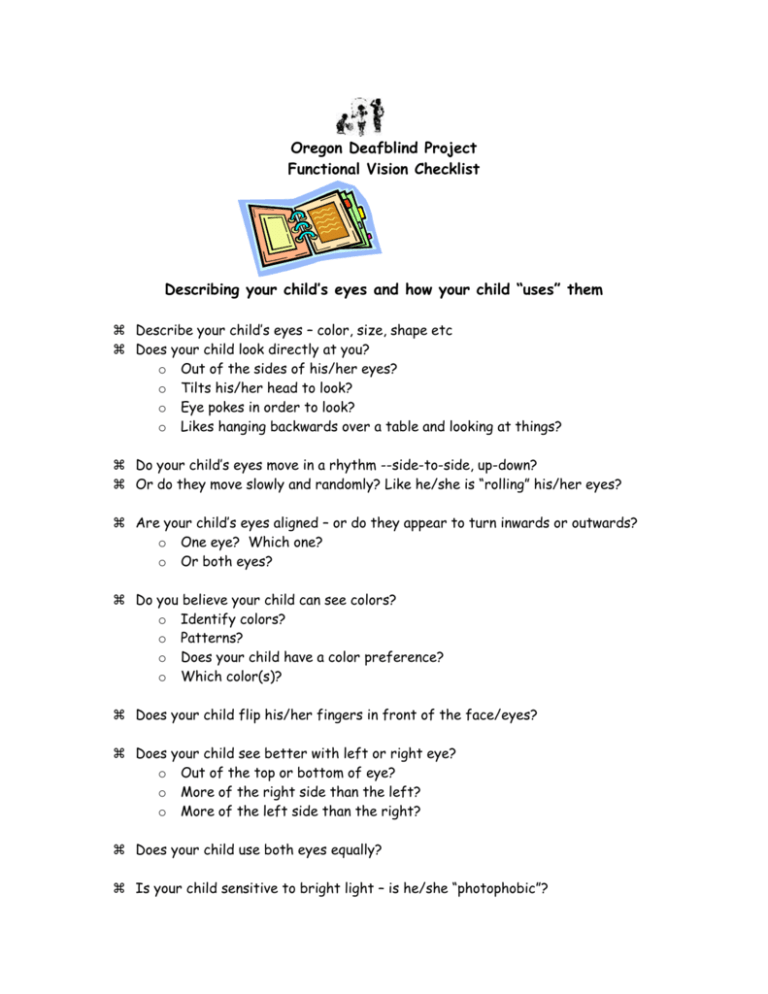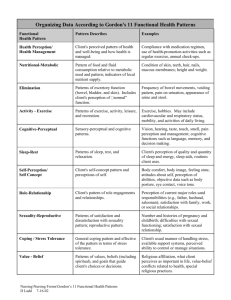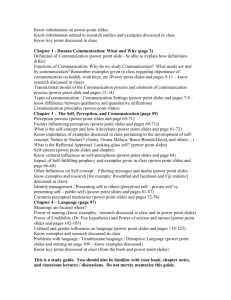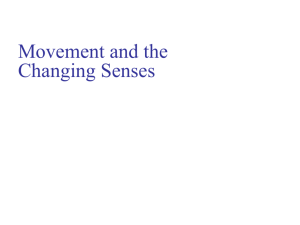Oregon Deafblind Project Functional Vision Checklist Describing
advertisement

Oregon Deafblind Project Functional Vision Checklist Describing your child’s eyes and how your child “uses” them Describe your child’s eyes – color, size, shape etc Does your child look directly at you? o Out of the sides of his/her eyes? o Tilts his/her head to look? o Eye pokes in order to look? o Likes hanging backwards over a table and looking at things? Do your child’s eyes move in a rhythm --side-to-side, up-down? Or do they move slowly and randomly? Like he/she is “rolling” his/her eyes? Are your child’s eyes aligned – or do they appear to turn inwards or outwards? o One eye? Which one? o Or both eyes? Do you believe your child can see colors? o Identify colors? o Patterns? o Does your child have a color preference? o Which color(s)? Does your child flip his/her fingers in front of the face/eyes? Does your child see better with left or right eye? o Out of the top or bottom of eye? o More of the right side than the left? o More of the left side than the right? Does your child use both eyes equally? Is your child sensitive to bright light – is he/she “photophobic”? o o o o o o Does he/she close eyes or partially shut them to avoid the brightness? When inside? Where do you notice this? What about outside? When do you notice this? Does your child have problems going from a brightly lit area to a dimly lit one? (e.g., from a sunny backyard, back into the house) What about from a dimly lit area to a bright area? (e.g., from inside to outside where it is sunny or the light is reflecting off snow) What about glare? (e.g., shiny magazines or books, shiny surface of cans of soda or food wrapping/packaging) Does your child follow/”track” (with his/her eyes) a moving item easily? o For a certain distance or direction only? o Not beyond midpoint? o Up to down o Side to side? o Is there a time lag in tracking – i.e. does he/she take a second or so additional time to do this? Estimate how long. Here are some typical visual tasks to think about: While on a car trip: o Does your child look out of the window o Stay looking straight ahead, or o Play with nearby items (but only through touch)? Does your child look at street lights as you pass by them? Other lights (in the ceiling)? Does he/she stare at a bright window? Does you child watch television? o How close or far does he/she have to be in order for the screen to keep his/her attention? Will your child visually attend to a computer screen? Does your child visually search for your pet dog, cat etc? When flying a kite – will your child look up at the kite as it goes up? o If yes – how far away does it need to be for him/her to “lose” it? What does your child look at in the lunchroom at school? o Do you think your child sees his/her plate, cup etc? o Do you think he/she can identify what is on the plate and where on the plate the items are located? Will your child look at herself/himself in a mirror? o Describe what he/she does? Can your child visually locate a toy? o If a favorite toy is mixed up with a lot of other toys, can your child find the favorite easily? When in a public place – Mall, swimming pool, grocery store etc – what does your child focus his/her attention on? o Do you notice anything in common between these? Does your child prefer to watch people or things? Does your child reach for objects and end up over-reaching or under-reaching? Does your child have problems with depth perception – e.g. stairs, when surfaces change – e.g. wooden floor to carpeted. Will your child “scan” (systematically and visually search for something) in order to find something or someone? How far can your child see – and still see “okay”? o Where does your child hold a book or toy in order to see it better? o When you are walking towards him/her – at what point does your child recognize and acknowledge you? o When your child eats, how close does he have to be to actually SEE what is on his/her plate? o Can your child find his/her “lost” item – especially if it is partially visible? Does your child enjoy activities such as o Coloring? o Coloring within lines? o Cutting and pasting? o Drawing pictures? o Filling in the details on pictures? o Writing? o Can your child tell what a picture is if it is a broken-line picture? o Can your child trace lines etc? o Can your child draw a line between two lines – mazes? Is your child able to put together things: o Simple graded stackable cups o Other stackable items, blocks, beads, Lego pieces o Puzzles – simple or complex Can your child match things that “go together”? o By color? o By shape or size? o Just because they are supposed to go together (e.g. cup and saucer; your pet dog and the leash)? Can your child put items in the correct (sequence) order? Does your child understand that objects: o Are the “same” objects whether they are hidden from view or not? o Are the same even if they may look different from a different angle? o Can be represented in line drawings, photographs – and may “show up” in various places such as magazines, newspapers, notice boards etc.? If your child can see a piece of an object (the rest is hidden from view) – does he know or can he guess what it is? (e.g., the spout of a teacup, a part of a familiar and favorite toy) Does your child have good coordination between: o Eyes and hands? What are some of the things he/she does that tells you this? o Eyes and feet? What are some of the things he/she does that tells you this? (See following page for an outline of a “formal” Functional Vision Assessment. The above items look at many of the FVA components – by observing what a child does and how he reacts to his people and things in his/her environment) Components of a FVA: Appearance of eyes and presence of corrective lenses Visual reflexes: Pupillary reflexes, Defensive Blink,. Doll’s eye response (vestibular ocular reflex) Visual responsiveness and perception: Light perception, light projection, shadow & form perception, detection of motion. Muscle balance Eye preference Oculomotor behaviors: fixation, convergence and divergence, tracing, tracking, shift of gaze, scanning Field of vision Color vision Depth perception Figure-ground perception Light sensitivity and light-dark adaptation Contrast sensitivity Visual acuity: Preferred viewing distance, formal testing methods, near and distance acuity cards or charts, functional acuity estimate. Current print functioning Reading rate and comprehension Visual motor coordination: visual fine motor coordination, visual gross motor coordination Visual-cognitive skills: visual imitation of movement, identification, matching, sorting, and classification of objects and pictures Visual sequencing Visual perception skills (Taken from “Looking to Learn” (p. 43) Looking to Learn: Promoting Literacy for Students With Low Vision by Frances Mary D'Andrea and Carol Farrenkopf (Paperback - Aug. 1, 2000) New: $46.02 (Amazon.com), $45.95 or $23.00 online (from publisher American Foundation for the Blind)







